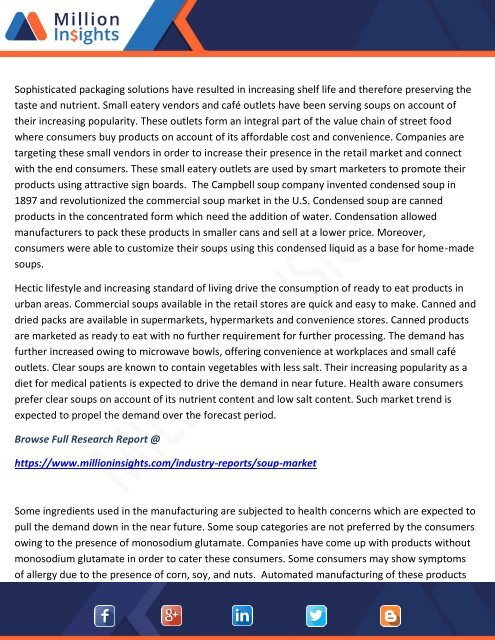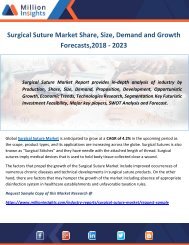Soup Market Growth Potential, Opportunities, Industry Specific Challenges and Risks 2025
Global soup market is expected to witness a steady growth owing to its presence in daily diet especially in South East Asia. Soup consumption by people under medical observation is expected to trigger the market growth in near future. A soup is a liquid food mostly consisting of vegetables and meat. It is usually served warm before any meals and is a very popular appetizer. Most forms of soup are taken before a meal to stimulate the appetite. The existence of soup can be traced far back, however its commercialization started in the 19th century with the invention on canning.
Global soup market is expected to witness a steady growth owing to its presence in daily diet especially in South East Asia. Soup consumption by people under medical observation is expected to trigger the market growth in near future. A soup is a liquid food mostly consisting of vegetables and meat. It is usually served warm before any meals and is a very popular appetizer. Most forms of soup are taken before a meal to stimulate the appetite. The existence of soup can be traced far back, however its commercialization started in the 19th century with the invention on canning.
Create successful ePaper yourself
Turn your PDF publications into a flip-book with our unique Google optimized e-Paper software.
Sophisticated packaging solutions have resulted in increasing shelf life <strong>and</strong> therefore preserving the<br />
taste <strong>and</strong> nutrient. Small eatery vendors <strong>and</strong> café outlets have been serving soups on account of<br />
their increasing popularity. These outlets form an integral part of the value chain of street food<br />
where consumers buy products on account of its affordable cost <strong>and</strong> convenience. Companies are<br />
targeting these small vendors in order to increase their presence in the retail market <strong>and</strong> connect<br />
with the end consumers. These small eatery outlets are used by smart marketers to promote their<br />
products using attractive sign boards. The Campbell soup company invented condensed soup in<br />
1897 <strong>and</strong> revolutionized the commercial soup market in the U.S. Condensed soup are canned<br />
products in the concentrated form which need the addition of water. Condensation allowed<br />
manufacturers to pack these products in smaller cans <strong>and</strong> sell at a lower price. Moreover,<br />
consumers were able to customize their soups using this condensed liquid as a base for home-made<br />
soups.<br />
Hectic lifestyle <strong>and</strong> increasing st<strong>and</strong>ard of living drive the consumption of ready to eat products in<br />
urban areas. Commercial soups available in the retail stores are quick <strong>and</strong> easy to make. Canned <strong>and</strong><br />
dried packs are available in supermarkets, hypermarkets <strong>and</strong> convenience stores. Canned products<br />
are marketed as ready to eat with no further requirement for further processing. The dem<strong>and</strong> has<br />
further increased owing to microwave bowls, offering convenience at workplaces <strong>and</strong> small café<br />
outlets. Clear soups are known to contain vegetables with less salt. Their increasing popularity as a<br />
diet for medical patients is expected to drive the dem<strong>and</strong> in near future. Health aware consumers<br />
prefer clear soups on account of its nutrient content <strong>and</strong> low salt content. Such market trend is<br />
expected to propel the dem<strong>and</strong> over the forecast period.<br />
Browse Full Research Report @<br />
https://www.millioninsights.com/industry-reports/soup-market<br />
Some ingredients used in the manufacturing are subjected to health concerns which are expected to<br />
pull the dem<strong>and</strong> down in the near future. Some soup categories are not preferred by the consumers<br />
owing to the presence of monosodium glutamate. Companies have come up with products without<br />
monosodium glutamate in order to cater these consumers. Some consumers may show symptoms<br />
of allergy due to the presence of corn, soy, <strong>and</strong> nuts. Automated manufacturing of these products

















